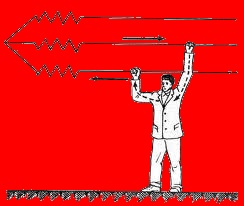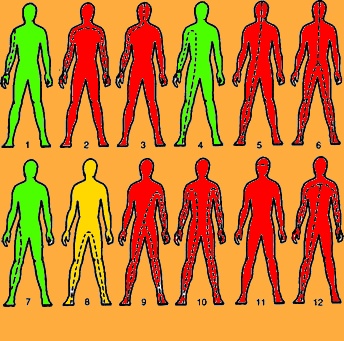Electric current passing through the human body can cause two types of injuries — electric shock and electric trauma. Electric shock is more dangerous because it affects the entire body. Death occurs from paralysis of the heart or respiration, or sometimes from both at the same time.
Electrical Injuries:
Electric traumas are defined as electrocution of external parts of the body; these are burns, skin metallization, etc. Electric injuries are, as a rule, of mixed character and depend on the magnitude and type of current flowing through the human body, the duration of its effect, the paths through which the current passes (Figure 1, 2 ), as well as on the physical and mental state of the person at the time of injury.


Alternating current of industrial frequency:
A person starts to feel at 0.6-15 mA. Current 12-15 mA causes severe pain in fingers and hands. A person can withstand this condition for 5-10 s, and can independently remove his hands from the electrodes. A current of 20-25 mA causes very severe pain, the hands become paralyzed, breathing becomes difficult; a person cannot independently free himself from the electrodes. At a current of 50-80 mA, respiratory paralysis occurs, and at 90-100 mA — paralysis of the heart and death.
The effect of direct current on humans:
The human body is less sensitive to direct current. Its effect is felt at 12-15 mA. A current of 20-25 mA causes a slight contraction of the arm muscles. Only at a current of 90-PO mA respiratory paralysis occurs. The most dangerous — alternating current with a frequency of 50-60 Hz. With increasing frequency, currents begin to spread over the skin surface, causing severe burns, but not leading to electric shock.
The amount of current flowing through the human body depends on the resistance of the body and the applied voltage. The greatest resistance to current is provided by the upper stratum corneum of the skin, devoid of nerves and blood vessels. In dry, undamaged skin, the resistance of the human body to electric current is 40,000-100,000 ohms.
The horny layer is of negligible thickness (0.05-0.2 mm) and is instantly punctured at a voltage of 250 V. Damage to the stratum corneum reduces the resistance of the human body to 800-1000 ohms. The resistance also decreases with increasing time of current exposure. Therefore, it is very important to quickly remove the victim from contact with live parts.
The outcome also depends to a large extent on the path of the current in the human body. The most dangerous paths are the arm-leg and arm-arm paths, when the greatest part of the current passes through the heart.
Physical and mental state of a person has a great influence on the value of resistance and, consequently, on the outcome of electric shock. Increased sweating of the skin, fatigue, nervous excitement, intoxication lead to a sharp decrease in the resistance of the human body (up to 800-1000 ohms). Therefore, even relatively small voltages can lead to electric shock.
Everyone working with electrical and radio equipment should remember that it is not the voltage that affects the human body, but the magnitude of the current. Under unfavorable conditions even low voltages (30-40V) can be life-threatening. If the resistance of the human body is 700 ohms, then even 35V will be dangerous. So, when working with electricity, always be careful and follow the rules of electrical safety ! ! !

